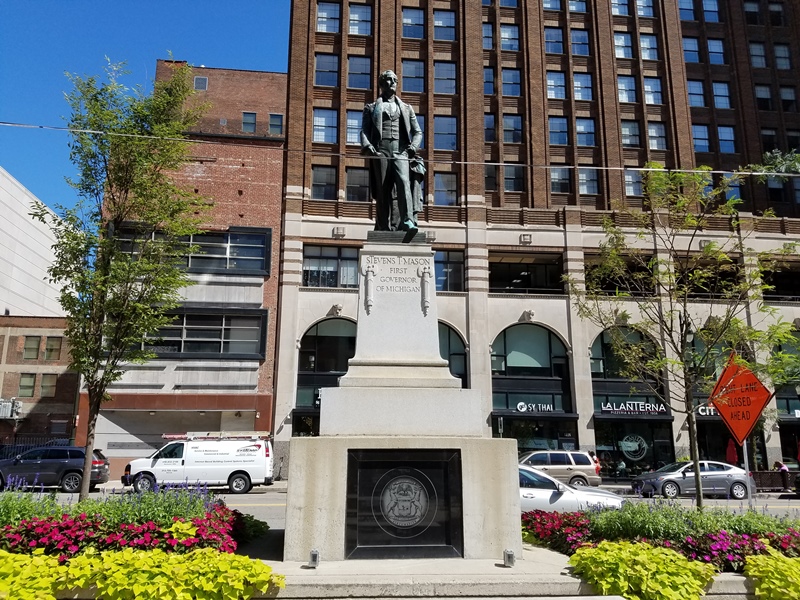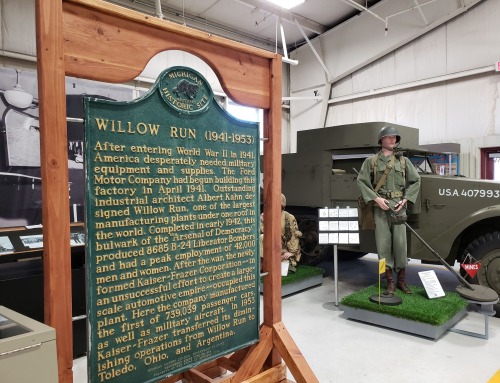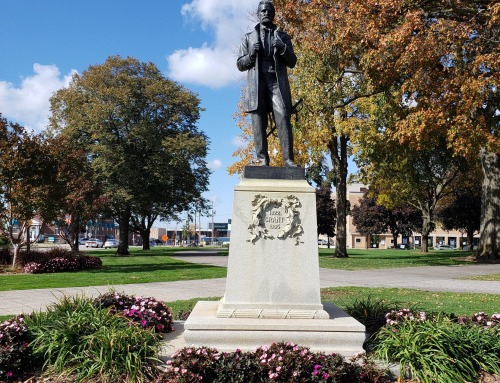Stevens Mason wasn’t born in Michigan. He didn’t die in Michigan either, yet he is very well-known for being a true Michiganian, and his influence on our state is undeniable. Also known as the Boy Governor, Stevens was instrumental in Michigan gaining statehood. The month of September has quite a few important dates in our state, and a couple of them revolve around this interesting man who had a huge impact on our state, along with a tragic, premature end.
Stevens Thomson Mason was born into a very political family on October 27, 1811 in Leesburg, Virginia. His grandfather, also named Stevens, was a US Senator from Virginia, his great-grandfather, Thomas, was the Chief Justice of the US Supreme Court and his great-grand-uncle was George Mason, who was chosen for the Constitutional Convention in 1787. In 1812, the Mason family moved to Lexington, Kentucky, where Stevens’s father, John, worked as a lawyer. In 1830, the family moved again when John was appointed as the superintendent of the Michigan territory and superintendent of Indian affairs by President Andrew Jackson.
Even at a young age, Stevens showed an aptitude for politics. Many men schemed against President Jackson and any appointments he made, and Stevens helped his father fight many accusations and ploys against him. His cleverness, youthful idealism, and vision caught the eye of Michigan territorial governor Lewis Cass and even President Jackson himself. In 1831, John Mason was sent on a governmental mission to Mexico, and Stevens was named by Jackson to replace his father. This appointment was controversial, as many of Jackson’s political moves were, especially because of Stevens’s youth. He was only nineteen at the time, and could not even vote yet. The voting age then was 21.
Around the same time, Lewis Cass became Jackson’s Secretary of War. When Cass left for this position, Stevens stepped in to act as governor, as it was the common practice at the time for the secretary to do so. In August of 1831, George B. Porter was named to officially replace Cass as territorial governor. Porter arrived in Detroit, the capital of Michigan at the time, in late 1831. He was often absent from his duties, and Stevens acted as governor in his stead. It was during this time that he was nicknamed Boy Governor. His main objective at the time was to get statehood for Michigan. In 1832, he petitioned the US Congress for statehood, but they delayed acting on the petition.
When George Porter died of cholera in Detroit in July of 1834, Stevens officially took over as acting governor. On September 1, 1834, Stevens Mason opened a special session of the territorial legislature, once again trying to gain statehood for Michigan. At the session, he called for a census to determine if Michigan had a population large enough to apply for statehood. It did, but the situation was more complicated than that. At this same time, a piece of land known as the Toledo Strip was claimed by both Michigan and Ohio. President Jackson was unwilling to alienate his supporters in Ohio by giving Michigan its rightful land. This argument led to the Toledo War, and Stevens himself even led militia men to the strip to try and gain it for Michigan. President Jackson sent men to intercede in the dispute, but Stevens didn’t like the terms of the proposal and stood strong. Jackson removed Stevens from his position as territorial governor in August of 1835. On September 19, the order officially went into effect when John S. Hormer arrived in Michigan Territory to replace Stevens.
Stevens Mason remained popular in Michigan and kept fighting for the territory and its people throughout the Toledo dispute. Michigan voters approved a state constitution on October 5, 1835, and Stevens was elected the first governor. The US Congress, however, refused to recognize Michigan as a state until the Ohio conflict was resolved. Stevens didn’t let this stop him from making plans, however. He started preparing internal improvements for all of Michigan, programs that were considered quite ambitious. These plans included the development of three railroads and two canals for the territory.
In 1936, Stevens Mason finally agreed to a compromise reached by Congress, mostly because of financial difficulties. In this compromise, Michigan would agree to give the Toledo Strip to Ohio in exchange for the western two-thirds of the current Upper Peninsula (we already held the other third). At a convention in September of that year, Michigan delegates refused to go along with Stevens and the compromise. Stevens Mason didn’t give up. In a second convention in December, he was able to convince the delegates to agree to the terms, and on January 26, 1837, Michigan was admitted to the Union.
This was a big year for Stevens and the new state. He was elected as state governor, then negotiated to fund the internal improvements through the sale of $5,000,000 in bonds. This would be equivalent to $118 million today. Unfortunately, the Panic of 1837, a financial crisis that touched off a major depression throughout the country, caused this arrangement to fall apart. The company building the canal and the bank backing the loans fell into bankruptcy. The state was left with over $2,000,000 in bad debt with no way to pay them back in the foreseeable future.
Economic problems weren’t the only issues Stevens had to deal with. Early in 1838, he led the Michigan state militia in helping put down the Patriot War. During this conflict, renegade civilians in both Canada and the United States attempted to invade and annex parts of Canada (more on this conflict can be found in last month’s article on Fort Wayne). Multiple times, Stevens met with leaders of the Patriot group, continuing to show his ability to lead and how much respect others had for him. The war was over by the end of the year, and Stevens was able to focus once again on making Michigan a better state.
Stevens Mason knew the interior improvements were important for the development of Michigan, so he traveled to New York to drum up some financial support. Although he was unable to raise the funds he wanted, through his travels he became acquainted with a young New York socialite, Julia Phelps. The two were married on November 1, 1838.
Though he didn’t have funds readily available, Stevens still worked hard to build the state’s economy. He started a strong state university with the help of Fr. Gabriel Richard, which is now known as the University of Michigan. He worked on legislation to build the Soo Locks in Sault Ste. Marie, and he worked to make Michigan’s education system the best it could be at the time, even appointing Benjamin Pierce as superintendent of public instruction. This was the first appointment of its kind in the country. The population of Michigan boomed in the ten years Stevens served. Unfortunately, the financial troubles haunted him as the gubernatorial election of 1839 approached.
The 1835 Constitution of Michigan called for a new governor election every two years (this was changed to four years in 1963). Stevens feared a contentious campaign and embarrassing defeat in the election, so he decided to quit politics and start his own private law practice. His gubernatorial successor, William Woodbridge, a political rival of Stevens, did not let him leave politics quietly. Woodbridge was determined to place all the financial blame of Michigan on Stevens Mason. He also charged the former governor with corruption related to the $5,000,000 loan from 1837. Stevens tried to defend himself, but his reputation was ruined.
In 1842, 30-year-old Stevens left Michigan for New York City. He planned to open a new law practice with the help of his wealthy father-in-law. He struggled to build up a clientele, and was never able to make it successful. In the winter of 1842, he developed pneumonia. Stevens T. Mason, Boy Governor and hero of Michigan statehood, died at the age of 31 on January 4, 1843. He left behind his wife and three children, Stevens Jr., Dorthea, and Thaddeus, aged three through one.
Even after his death, Stevens Mason moved around. He was initially buried in New York City, but in 1905, his 92-year-old sister Emily, daughter Dorthea and other living family members accompanied his remains to Detroit to be reinterred at Capitol Park. This was the site of the old Michigan capitol building where Stevens worked so diligently. On October 27, 2010, he was moved one final time to a newly-built vault in the pedestal beneath a bronze statue of himself in Capitol Park.
Stevens T. Mason did much for the state of Michigan; one could even argue he founded it. He was determined to gain Michigan its statehood, and accomplished this goal. He made Michigan a desirable place to live, and worked hard to improve the quality of life for its residents. Unfortunately, it seems as though the political game was too much for this youthful, idealistic young man. Perhaps he would have been able to regroup and rejoin politics as a more established man, but unfortunately his life was cut short. Despite his limited years, he was a very successful man, and we Michiganians owe him a great deal.







Leave A Comment
You must be logged in to post a comment.